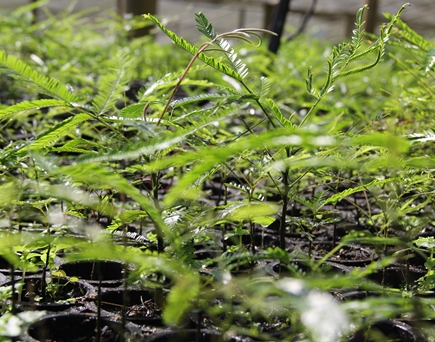“We are made of values. The spirit of serving is present in our daily lives, strengthening our bonds and...
Land Conservation Organization attains international certificates
DATE: 03/12/2018

Seedlings planted in the organization’s nursery
Five years after validating a Group of Projects involving forest restoration and Agroforest Systems (SAF) on the Pratigi Environmental Protection Area (APA), the Land Conservation Organization (OCT) had an area of 81 hectares verified by Rainforest Alliance. From 2011 to 2016, this first group of projects benefitted 18 family farmers who ceded areas on their properties for restoration and the implementation of SAFs. This verification, which is unprecedented in the Atlantic Forest, confirms that the programs implemented by OCT do in fact remove from the air the amount of carbon indicated.
To neutralize the pollution they emit, some companies buy the carbon credits resulting from the actions implemented by OCT. It works like this: after validating an area and establishing a Group of Projects, OCT estimates the amount of carbon to be sequestered over three decades. That is because during its first thirty years of life, a single tree removes around 170 kilograms of carbon from the air to support its growth. Meanwhile, one hectare of planted area contains on average 1,666 trees. Accordingly, over thirty years, one hectare of trees removes up to 277 tons of carbon from the air, generating a carbon bank. The acquiring company determines how much credit it wants to buy from this fund, which allows it to operate more sustainably by offsetting an amount corresponding to the greenhouse gas emissions it produced. Bruna Sobral, which is responsible for indicators at OCT, explains that “any company anywhere in the world can buy carbon credits from Brazil.”
In November 2017, OCT received two certificates: the Verified Carbon Standard (VCS) and the Climate, Community & Biodiversity Standards (CCBS), which confirmed, respectively, the amount of carbon sequestration on the areas assessed and the impact from the SAFs established in the region. Before receiving the certificates, however, it had to validate, in 2011, the projects carried out on the Pratigi APA, which includes restoring headwaters and riparian buffer zones and implementing the SAF. This year, a second Group of Projects is being prepared for validation, which should undergo verification in 2021.
According to Bruna Sobral, these verifications must be carried out every five years. “The assessment encompassed the monitoring period from May 2011 to April 2016, during which time the project removed from the air 1,543 tons of carbon through the 81 hectares of planted area,” she explained. According to the document issued by the certifier, “the climate benefits are exceptional, due to the resilience against climate change effects, such as floods and droughts, and to the food security [for the implementation of biodiverse agroforestry systems] and water security.”
Joaquim Cardoso, executive director at OCT, said that the verification demonstrates the entire team’s dedication over the last five years. “This achievement by OCT demonstrates the breadth of its program, which attests to its completeness, meeting all of the principles of Development and Growth Integrated with Sustainability.”
OCT is supported by the Odebrecht Foundation through the Program for Sustainable Integrated Growth and Development (PDCIS).



No comments